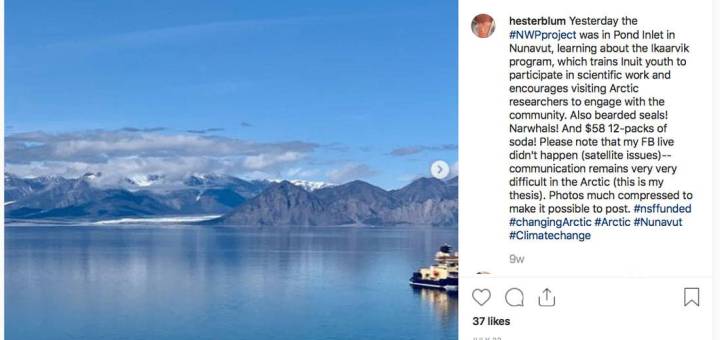The Social Media of Polar Exploration

Hester Blum, The News at the Ends of the Earth: The Print Culture of Polar Exploration (Duke University Press, 2019)
Posting on Instagram from the Northwest Passage Project in July of this year, author Hester Blum appended the following caption to several blurry photographs: “Please note that my FB live didn’t happen (satellite issues)—communication remains very very difficult in the Arctic (this is my thesis).” This absolutely is the thesis of The News at the Ends of the Earth: communication in the Arctic is “very very difficult,” but despite—perhaps because of— this difficulty, explorers strive to form community through communication. Arctic communication juxtaposes the sublime (“Narwhals!”) with the mundane (“$58 12-packs of soda!”), and takes on a unique form due to the extreme—and changing—climate. Faced with satellite issues, Blum compresses her photos and posts to Instagram anyway. And, as Blum writes, “faced with the natural antagonism of the extremity of polar conditions, nineteenth-century expedition members did not draw blanks; they printed gazettes.”
The News at the Ends of the Earth—published by Duke University Press and now available as an open-access eBook through the TOME initiative—is an engaging read and a wide-ranging academic exploration of the provoking question Blum poses in its preface: “Of all the ways that a polar expedition might find to pass the tedium of a long, dark, immobilized winter, I wondered, why would crew members feel an imperative not just to write a newspaper but to print it as well?” In answering this question, Blum’s book examines the processes and products of polar print culture, the experiences and perspectives of those involved in these expeditions and their publications, and the resonances between polar print culture a century ago and media—especially social media—in our current age of climate crisis.
Much of The News at the Ends of the Earth is devoted to a detailed review of the print materials produced by polar expeditions in the nineteenth and early twentieth centuries. In addition to the expected scientific records and personal journals, expedition members also produced a wide variety of creative works. Most prominent are the newspapers, which printed reports on shipboard activities, imaginative contributions (poetry, fiction, and songs), and elements parodying the expected contents of the genre. Print periodicals are by their very nature ephemeral; the ephemera of polar expeditions (newspapers, playbills, blank forms, advertisements) are rendered even more ephemeral by the conditions in which they were created (and, in some cases, left behind).

Image from the National Library of New Zealand.
Blum’s archival work is impressive and The News at the Ends of the Earth includes multiple photographic reproductions of the objects of her research. More impressive even than the survival of these ephemeral documents is the feat of their production. Polar conditions unsurprisingly make printing quite difficult, and explorers had to thaw ink, carve their own type, and print on both intended and scavenged materials. Blum classifies these documents under the genre of “polar ecomedia,” which she defines as “means of communication whose form, content, production, and circulation provide opportunities for their creators—and for Anthropocene observers today—to reframe their, and now our, understandings of ecological spaces and of human endurance in tenuous conditions.” While the “tenuous conditions” of polar expeditions resulted from the extreme climate of the poles (and at times also from human foibles including poor preparation and bad decisions), the tenuous condition of the Anthropocene results from the increasing probability of a calamitous climate future.

Image from Hathi Trust.
Some works of polar ecomedia also imagined such an apocalyptic future. Blum cites and discusses a contribution to the 1911 South Polar Times which uncannily resembles contemporary climate discourse: “Fragment of a Manuscript Found by the People of Sirius 8 When They Visited the Earth during Their Exploration of the Solar System,” by George Simpson, imagines a future expedition crew—much like the one of which he himself was a member—exploring a post-human-extinction Earth. In the final era of humanity recorded in this fictional found document, “the great question of the day was, Does climate change?” Simpson’s narrative jokingly alludes to his own expedition, as the fictional author of the “found manuscript” writes, “My dying thoughts are of the folly which neglected the teachings of the Scientists of the British Antarctic Expedition 1910-1912.”

Image from Hathi Trust.
This dark humor has an even greater sting today as, over a century later, humanity has indeed neglected these early warnings about human impact on climate; the imagined future of this work of speculative fiction now seems frankly plausible. Indeed Simpson’s narrative does not by any means seem old—although written over a century ago, it is of a piece with contemporary speculative journalism about the environment (consider for example High Country News’s August 19, 2019 “Speculative Journalism Issue” which mimics the periodical’s own genre of environmental and tribal reporting as if written in 2068). Much of the other polar ecomedia Blum discusses seems as uncannily prescient as Simpson’s. Blum suggests that the century between these texts and our present moment “might as well be a simultaneity” when considered on a geologic timescale. Not only are the writings of polar explorers relevant to our current moment, but relative to the age of the environment itself they are of the current moment.
Throughout The News at the Ends of the Earth, Blum notes the similarities between social media and polar ecomedia: “In Arctic and Antarctic newspapers, contributors share witticisms, make observations on daily life, and relay inside jokes. They too circulate ‘fake news’ (albeit for puckish effect). Like polar ecomedia, tweets and other social media posts are ephemeral. Like Antarctic missions, they have both private and public audiences.” But the print culture of polar exploration is not merely like social media: as one of the most delightful sections of Blum’s book reveals, polar ecomedia from a century ago also appears as social media content today. Chapter three of The News at the Ends of the Earth includes a section devoted to the Twitter feeds of Ernest Shackleton (@EShackleton) and Robert Falcon Scott (@CaptainRFScott), which tweet excerpts and paraphrases of expedition records one hundred years after the fact. If the social media presence of long-dead polar explorers seems odd, the content of these tweets is even more peculiar.
In hindsight, the ponies were a mistake.
— Ernest Shackleton (@EShackleton) March 1, 2014
Blum dives deep into the strangeness of these explorers’ predilection for ponies—a perverse choice of working animal remarkably unsuitable to polar conditions—quoting a tweet from @EShackleton: “‘In hindsight, the ponies were a mistake.’” This extended discussion of the doomed ponies is, for Blum, representative of the “British reluctance to adapt to polar conditions,” much like Shackleton’s own reluctance to learn to ski. Blum insightfully connects the strangeness of posthumous tweeting with the oddity of polar ponies: “Both ponies in Antarctica and the textual form of the tweet are out of place.”
This out-of-place-ness is a key characteristic of polar print production: a daily newspaper’s morning edition makes little sense during months when the sun never rises; a printing press is an odd item to bring along on a polar expedition that isn’t even bringing skis; it seems strange for a publication’s audience to consist almost entirely of its own contributors. Polar print production seems less strange, though, when paralleled to today’s social media, and the social media accounts of polar explorers, in particular. As Blum explains, “from the time and place of their original scene of writing or publishing, the tweets enact the synchronicity of polar literary circulation in their limited, fragmented form.” These tweets also “underscore that views of nature and human and animal adaptability are only ever partial.”

Blum asks: “Are ponies any more timely, any less absurd, than humans when translocated to Antarctic spaces?” Photograph of Ernest Shackleton’s Nimrod expedition from Wikimedia Commons.
The print documents that survive from polar expeditions a century ago similarly offer only a partial view of the stories of survival (or disaster) underlying the moments of their production. In addition to the imaginative productions printed and circulated among expedition members (newspapers, playbills, broadsides, etc.) to which several chapters of The News at the Ends of the Earth are devoted, Blum also discusses documents “addressed to a conjectural future audience in the Arctic itself”: messages in bottles, updates sent by balloon, blank forms to be filled and left in cairns. Most of these never met an audience; our only records of these documents are copies made to keep aboard ship. Blum emphasizes that “The copies exist precisely because Arctic blanks are expected to become dead letters.” Even as melting polar ice today may begin to uncover materials left behind long ago, the ephemerality of print media and the extremity of polar conditions mean that many documents—and many lives—have been forever lost.
Shackleton’s ponies are not the only tragic losses recounted in The News at the Ends of the Earth; many expedition members succumbed to the hostile conditions of the polar climate or died as a result of poor preparation or tragic mistakes by expedition leaders. Later chapters in The News at the Ends of the Earth emphasize how “accounting for the persistent insufficiencies of Western methods has historically been one way to gauge the climatic and geographical extremity of the Arctic.” White Western explorers were generally reluctant to adopt Indigenous survival practices (using sled dogs, eating seal meat to prevent scurvy, etc.), and “Western methods” were even more “insufficient” in locating the lost Franklin expedition: numerous searches over the course of decades, even with the growing technological resources of the late 20th and early 21st centuries, failed to locate the lost ships until 2014 and 2016. As Blum notes, “the ships were eventually found just where the Inuit had repeatedly said they were.”
As Blum’s introduction emphasizes, white Westerners frequently misunderstood Indigenous communication practices. Blum contrasts Anglo-American cairns—rock piles bearing supplies or messages within—with Inuit Inuksuit cairns that “transmit messages in their very shape and construction.” Not understanding these messages, British expeditions would demolish the Inuksuit “in hopes of finding letters or a food cache.” Indeed, these expeditions’ publications are often indebted to Inuit, Yupik, Iñupiat, Sami, and other Arctic Indigenous knowledges, but usually without acknowledgement by the explorers writing them. Blum points out that “the refusal of many white Westerners to engage with or credit Indigenous knowledge has been costly in multiple ways for hundreds of years.” The News at the Ends of the Earth recounts the surprising successes of polar expeditions in producing enduring print materials under extreme conditions as well as the tragedies brought on by this extremity.
Blum’s book is a lively and enjoyable account of a fascinating historical period and its practices—but it is also vitally relevant for our current moment. “The question for humans in the Anthropocene is whether we too can write a survival story while in extremity,” Blum concludes, proposing that “some of the practices of polar expedition members—their triumphs and mistakes, yes, but also their ecomedia production and reproduction processes—can provide a model and some hope.” The News at the End of the Earth offers models of communication practices shaped by and suitable for extreme climates: “In a moment when human and nonhuman life feels increasingly ephemeral within the broader scope of planetary climate crisis—even as human actions have propelled these extreme conditions—polar and oceanic perspectives offer representational keys with which we might begin to find conceptual language instrumentalizable to life (and endurance) in the Anthropocene.”
In the long darkness of polar winters far from the comforts of home, explorers wrote and printed to create community, find humor amidst deprivation, and imagine potential futures. In our own moment of climate crisis, digital forms of media offer similar possibilities to connect with each other as audiences and activists navigating a rapidly changing world. Though ephemeral and fragmentary, social media is a vital mode of representation. Twitter images from the “Fridays for Future” climate strike in recent weeks show small protests in remote villages side-by-side with mass walkouts in major cities, revealing the critical mass of global participation in the strike. Just as Twitter hashtags can capture and link these disparate, distant moments of climate activism, the visual language of Instagram can show us what we’re striking for: unmelted ice sheets, clear Arctic seas, “Narwhals!”
Featured image: A July 22, 2019 post on Hester Blum’s Instagram account about Arctic communication, reproduced with Blum’s permission.
Carie Lyn Schneider is Assistant Professor in the department of Communication, English and Foreign Languages at Cameron University in Lawton, Oklahoma where she specializes in American literature and literary theory. Twitter. Contact.



You must be logged in to post a comment.